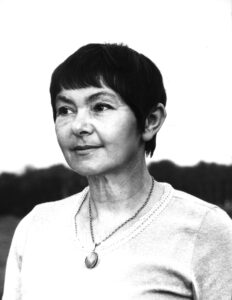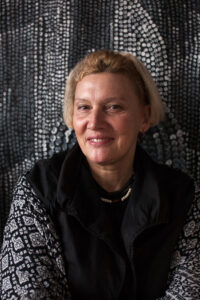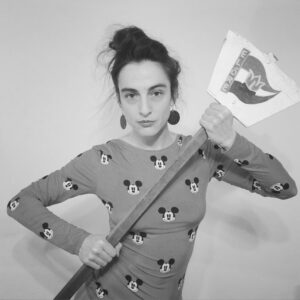Maja Štefančíková

– is a graduate of the Academy of Fine Arts and Design in Bratislava, where she studied glass, sculpture and intermedia between 2000 and 2011. Since 2012, she has been the editor of the Slovak section of the Artalk.cz portal. Currently, she works as an assistant professor at the Department of Intermedia at the AFAD. She lives in Bratislava.
Maja Štefančíková’s creates temporary performative situations that emerge primarily through movement and voice. She is experienced in various types of media – from glass to video to dance, but the body in space and time is the the one she chooses most often. She focuses on constructing performative situations, or performative environments, that are contemplative yet still playful. She conceives these situations as continuous, long-lasting events in galleries or public spaces. She creates a fixed choreographic structure that is additionally modified by external factors.
The medium and the core of her work is the body. Body is not a static and fixed entity, it is constantly in transformation. A body working, dreaming, thinking, dancing or resting. You can wear anything and still be transformed into new surfaces: the body will always attest to who you are and what you feel. Performative work uses precisely this potential within the human body. Choreography, on the other hand, is one of the blueprints of the process of creating a movement piece. The spectator perceives its beginning, progress and end, multiple repetitions. As essential components of choreography, movement and sound take place in a specific time and space, then disappear. These coordinates determine Štefančíková’s performative acts, in which she often engages in this act of contextualising the void, using movement and words to create something that does not exist. Language and its performative forms are the building blocks of her work.
She is interested in the creative process as well as the intangible work that is its result. Through this thematic angle, her performative act – as a creation in a specific time and space – makes it possible to explore social relations and topics without the use of static matter. Thanks to this, she understood that she can move across several disciplines – dance, sculpture or video – and explore their boundaries, as well as explore interpersonal relationships in mixed groups or the interaction with the audience. In her works, the audience is always confronted with itself, with its own presence in a situation, with something it cares about. The viewer influences and shapes the situation, Štefančíková counts with their emotional involvement. She is interested in who it is that is directing the events at any given moment.
She chooses different people for the role of performers, from amateurs to professionals. The groups she works with are varied, actors and dancers of divers genders, but also elderly people. She likes to work with people who have a background in theatre, music, dance and visual arts. She directs the performers and she designs the movement and vocal compositions (that’s the rehearsal process).
The things she works on she tries and works out herself at home. In the first phase, she pitches individual ideas to herself, then films and watches them. She rehearses mostly at home, occasionally using a small dance studio or the roof if she needs more space. Rehearsals then take place in larger spaces – in the second phase, when she is already in direct contact with a group of performers. When she introduces a new thing, she rarely joins them because she wants to see the piece from the outside.
By dematerialising her works, she responds, among other things, to the excessive supply and creation of objects that developed in Western societies in the 20th century. She works on the premise that production overwhelms humanity and that we currently produce more than we need, which has a negative impact on climate conditions. She addresses social phenomena such as work, institutions or art operations; explores and comments on concepts such as aesthetic experience, perception and memory. At the same time, she works with the topic of audience perception, which she puts to the test through inconspicuous, in fact often invisible, long-time empty, silent or otherwise subversive inputs. Through these, she tries to activate hidden levels of perception.
For example, in the centre of Brno, she staged the project Prchavé súsošie (2019), in which a group of performing people traveled from square to square and, with the help of stone carving tools that produced a typical sound, carved an acoustic monument. She took inspiration from the act of moving through the city, from its acoustic mass, but also the history of the disappeared, unbuilt statues and monuments, and last but not least, from tourists, who often stop at the squares or at the statues and take photos, capturing the frozen, as if petrified, body. An important component was the audience, who dictated the duration of the event itself. If the audience interacted, they could change the duration. The event could have lasted six minutes (that’s how long the musical composition was), but also two hours. Among other things, she was testing whether the rhythm of the acoustic composition spreads through the city like a “melody” and whether people are able to notice this process.
When working with the public space, it is quite common to refer to history, collective and individual memory, monuments and architecture, but in her works, Štefančíková also tries to involve visual, sound and olfactory sensations, which give the pieces complexity. Therefore, elements such as wind, smell, sun, various industrial sounds or even pedestrians on the street, play an important role. All these influences co-determine her thinking when composing the event. Her work and views are moreover influenced by various feminist concepts. One of Štefančíková’s projects at her residency in Schaubmar’s mill, for example, dealt with research of hysteria, which was treated as a women’s disease in the now-abandoned psychiatry building on the site. The word hysteria itself is gender-specific (from ancient Greek hystera = lower abdomen, uterus, through Latin hystericus; archaically: neurosis) and very rich in meaning. At the residency, she researched what it affected and what forms of representation hysteria has today, despite the fact that it has long since ceased to be a disease. Štefančíková perceives feminism as extremely diverse and, in its essence, as a direct part of the history of thoughts, attitudes and actions that show us what it means to be a human being.
The text was written in collaboration with Miroslava Urbanová (2022).
1Image: Ephemeral Sculpture, 2019, Brno Art Open – Jsem závislý objekt, Dům umění, Brno, Czech Republic, photo: Eva Rybářová2Image: Ephemeral Sculpture, 2019, Brno Art Open – Jsem závislý objekt,Dům umění, Brno, Czech Republic, photo: Eva Rybářová
3Image: Ephemeral Sculpture, 2019, Brno Art Open – Jsem závislý objekt,Dům umění, Brno, Czech republic, photo: Dana Tomečková
4Image: Ephemeral Sculpture, 2019, Brno Art Open – Jsem závislý objekt,Dům umění, Brno, Czech republic, photo: Eva Rybářová
5Image: Spatial Sketches, 2018, Gallery Plusmínusnula, Žilina, photo: Gosia Cwiech
6Image: Spatial Sketches, 2018, Gallery Plusmínusnula, Žilina, photo: Gosia Cwiech
7Image: The Cloud of Generosity in collaboration with Nóra Ružičková, 2017, Petržalka, Bratislava, photo: Adam Šakový
8Image: The Cloud of Generosity in collaboration with Nóra Ružičková, 2017, Petržalka, Bratislava, photo: Adam Šakový
9Image: Close Encounters, 2022, We Are All Emotional, Divadlo X10, Praha, Czech Republic, photo: Tereza Havlínková
10Image: Close Encounters, 2022, We Are All Emotional, Divadlo X10, Praha, Czech Republic, photo: Tereza Havlínková
11Image: Close Encounters, 2022, We Are All Emotional, Divadlo X10, Praha, Czech Republic, photo: Tereza Havlínková

– je absolventkou Vysokej školy výtvarných umení v Bratislave, kde medzi rokmi 2000 až 2011 študovala sklo, sochu a intermédiá. Od roku 2012 je editorkou slovenskej sekcie portálu Artalk.cz. V súčasnosti pôsobí ako odborná asistentka na Katedre intermédií VŠVU. Žije v Bratislave.
Maja Štefančíková sa venuje vytváraniu dočasných performatívnych situácií, ktoré vznikajú predovšetkým cez pohyb a hlas. Má skúsenosti s rôznymi druhmi médií – od skla cez video až po tanec, avšak telo v priestore a čase je médium, ktoré si vyberá najčastejšie. Vytvára performatívne situácie či performatívne environmenty, ktoré sú kontemplatívne, ale zároveň aj hravé. Situácie koncipuje ako nepretržité, dlhotrvajúce akcie v galérii či vo verejnom priestore. Vytvára pevnú choreografickú štruktúru, ktorá je modifikovaná aj vonkajšími faktormi.
Médiom a jadrom jej práce je telo. Telo nie je statickou a pevnou entitou, neustále sa transformuje. Telo pracujúce, snívajúce, mysliace, tancujúce či oddychujúce. Môžete mať oblečené hocičo, a pritom sa transformovať do nových plôch: telo vždy bude vypovedať o tom, kto ste a čo cítite.
Performatívna akcia vužíva práve potenciál ľudského tela. Choreografia je zas jedným z plánov procesu tvorby pohybového diela. Divák vníma jej začiatok, priebeh a koniec, viacnásobné opakovanie. Pohyb a zvuk ako zásadné súčasti choreografie sa odohrávajú v konkrétnom čase a priestore, potom zaniknú. Tieto súradnice určujú Štefančíkovej performatívne vystúpenia, v ktorých sa často venuje práve kontextualizovaniu prázdna, pohybom a slovom vytvára niečo neexistujúce. Slovo a jeho performatívne podoby využíva v tvorbe ako stavebný materiál.
Zaujíma ju proces tvorby diela, rovnako ako aj nehmotné dielo, ktoré je výsledkom tohto procesu. Jej performatívna akcia ako tvorba v konkrétnom čase a priestore umožňuje cez tento tematický záber skúmať spoločenské vzťahy a témy bez využitia statickej hmoty. Vďaka tomu pochopila, že sa vie pohybovať naprieč viacerými disciplínami – cez tanec, sochu či video; skúmať ich hranice, ako aj spoznávať medziľudské vzťahy v zmiešaných skupinách či ľudskú interakciu s divákmi. Obecenstvo sa v jej prácach vždy konfrontuje samo so sebou, s vlastnou prítomnosťou v situácii, s niečím, na čom mu záleží. Divák alebo diváčka ovplyvňujú a formujú situáciu, Štefančíková počíta s ich emocionálnou zaangažovanosťou. Zaujíma ju, kto v danom momente riadi akciu.
Do úlohy performerov/iek si vyberá rôznych ľudí – od amatérov/ky až po profesionálov/ky. Skupiny, s ktorými pracuje, sú rôznorodé, najčastejšie sú to herci a herečky, tanečníci a tanečníčky, ale aj starší ľudia. Rada spolupracuje s ľuďmi, ktorí majú background v divadle, hudbe, tanci i vo vizuálnom umení. Performerov a performerky režíruje. Má premyslené pohybové a hlasové kompozície (to je proces skúšania).
Veci, na ktorých pracuje, rieši a skúša sama v domácom prostredí. V prvej fáze si nahadzuje jednotlivé nápady, potom si ich natáča a pozerá. Väčšinu času skúša doma, výnimočne využíva malú tanečnú sálu a prípadne strechu, ak potrebuje väčší priestor. V druhej fáze, keď je už v priamom kontakte so skupinou ľudí, prebiehajú skúšky vo väčších priestoroch. Keď uvádza novú vec, málokedy sa pripojí ku skupine preformerov, pretože chce dielo vidieť zvonku.
Dematerializáciou diel reaguje okrem iného na nadmernú ponuku a tvorbu objektov, ktorá sa rozvinula v západných spoločnostiach v 20. storočí. Vychádza z faktu, že produkcia ľudstvo zahlcuje, aktuálne vyrábame viac ako potrebujeme, čo má negatívny dopad na klimatické podmienky. Zaoberá sa spoločenskými fenoménmi ako práca, inštitúcie či umelecká prevádzka; skúma a komentuje estetický zážitok, vnímanie a pamäť. Venuje sa zároveň otázkam diváckej percepcie, ktorú testuje prostredníctvom nenápadných, často až neviditeľných, dlhodobo prázdnych, tichých alebo inak subverzívnych vstupov. Snaží sa nimi aktivovať skryté roviny vnímania.
V centre Brna napríklad realizovala projekt Prchavé súsošie (2019), v ktorom skupina performujúcich ľudí putovala z námestia na námestie a pomocou kamenosochárskych nástrojov, ktoré vydávali typický zvuk, vysekávali protagonisti akustický pamätník. Inšpiráciou jej bolo presúvanie sa mestom, jeho akustická hmota, ale aj história zmiznutých, nerealizovaných sôch a pamätníkov. V neposlednom rade však aj turisti, ktorí sa často zastavujú na námestiach alebo pri sochách a robia si fotografie, zachytávajú stuhnuté, akoby skamenené telo. Dôležitou zložkou bolo publikum, ktoré určovalo dĺžku trvania samotnej akcie. Ak obecenstvo vstúpilo do interakcie, mohlo dĺžku trvania diela zmeniť. Akcia mohla trvať šesť minút (taká dlhá bola hudobná kompozícia), ale aj dve hodiny. Okrem iného testovala, či sa rytmus akustickej kompozície šíri po meste ako „melódia“ a či ľudia tento proces dokážu zaregistrovať.
Pri práci s verejným priestorom je celkom bežné odkazovať na históriu, kolektívnu a individuálnu pamäť, pamiatky a architektúru, ale vo svojich dielach sa Štefančíková snaží zapájať aj vizuálne, zvukové a čuchové vnemy, ktoré prinášajú do diel komplexnosť. Dôležitú úlohu hrajú preto elementy ako napríklad vietor, vôňa, slnko či rôzne industriálne zvuky, alebo aj chodci/kyne na ulici. Všetky tieto vplyvy spoluurčujú jej rozmýšľanie pri komponovaní akcie. Jej tvorbu a uvažovanie ovplyvňuje aj veľa feministických konceptov a myšlienok. Jeden zo Štefančíkovej projektov počas rezidencie v Schaubmarovom mlyne sa napríklad zaoberal výskumom hystérie, ktorá sa liečila v rámci ženských chorôb v tamojšej, teraz opustenej budove psychiatrie. Samotné slovo hystéria je genderovo podmienené (zo starogr. hystera = podbrušie, maternica, cez lat. hystericus, archaicky neuróza) a významovo veľmi bohaté. Na rezidencii skúmala, čo všetko to zasiahlo a aké podoby reprezentácie má hystéria dnes, a to i napriek tomu, že ako choroba už dávno neexistuje. Feminizmus Štefančíková vníma ako nesmierne rozmanitý a vo svojej podstate ako priamu súčasť histórie myšlienok, postojov a činov, ktoré nám ukazujú, čo je to byť ľudskou bytosťou.
Text bol napísaný v spolupráci s Miroslavou Urbanovou (2022).
1Obrázok: Prchavé súsošie, 2019, Brno Art Open – Jsem závislý objekt, Dům umění, Brno, Česká republika, foto: Eva Rybářová2Obrázok: Prchavé súsošie, 2019, Brno Art Open – Jsem závislý objekt, Dům umění, Brno, Česká republika, foto: Eva Rybářová
3Obrázok: Prchavé súsošie, 2019, Brno Art Open – Jsem závislý objekt, Dům umění, Brno, Česká republika, foto: Dana Tomečková
4Obrázok: Prchavé súsošie, 2019, Brno Art Open – Jsem závislý objekt, Dům umění, Brno, Česká republika, foto: Eva Rybářová
5Obrázok: Priestorové skice, 2018, Galéria Plusmínusnula, Žilina, foto: Gosia Cwiech
6Obrázok: Priestorové skice, 2018, Galéria Plusmínusnula, Žilina, foto: Gosia Cwiech
7Obrázok: Oblak štedrosti v spolupráci s Nórou Ružičkovou, 2017, Petržalka, Bratislava, foto: Adam Šakový
8Obrázok: Oblak štedrosti v spolupráci s Nórou Ružičkovou, 2017, Petržalka, Bratislava, foto: Adam Šakový
9Obrázok: Blízke stretnutia, 2022, We Are All Emotional, Divadlo X10, Praha, Česká republika, foto: Tereza Havlínková
10Obrázok: Blízke stretnutia, 2022, We Are All Emotional, Divadlo X10, Praha, Česká republika, foto: Tereza Havlínková
11Obrázok: Blízke stretnutia, 2022, We Are All Emotional, Divadlo X10, Praha, Česká republika, foto: Tereza Havlínková


